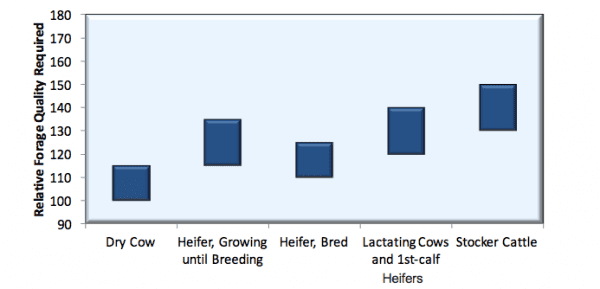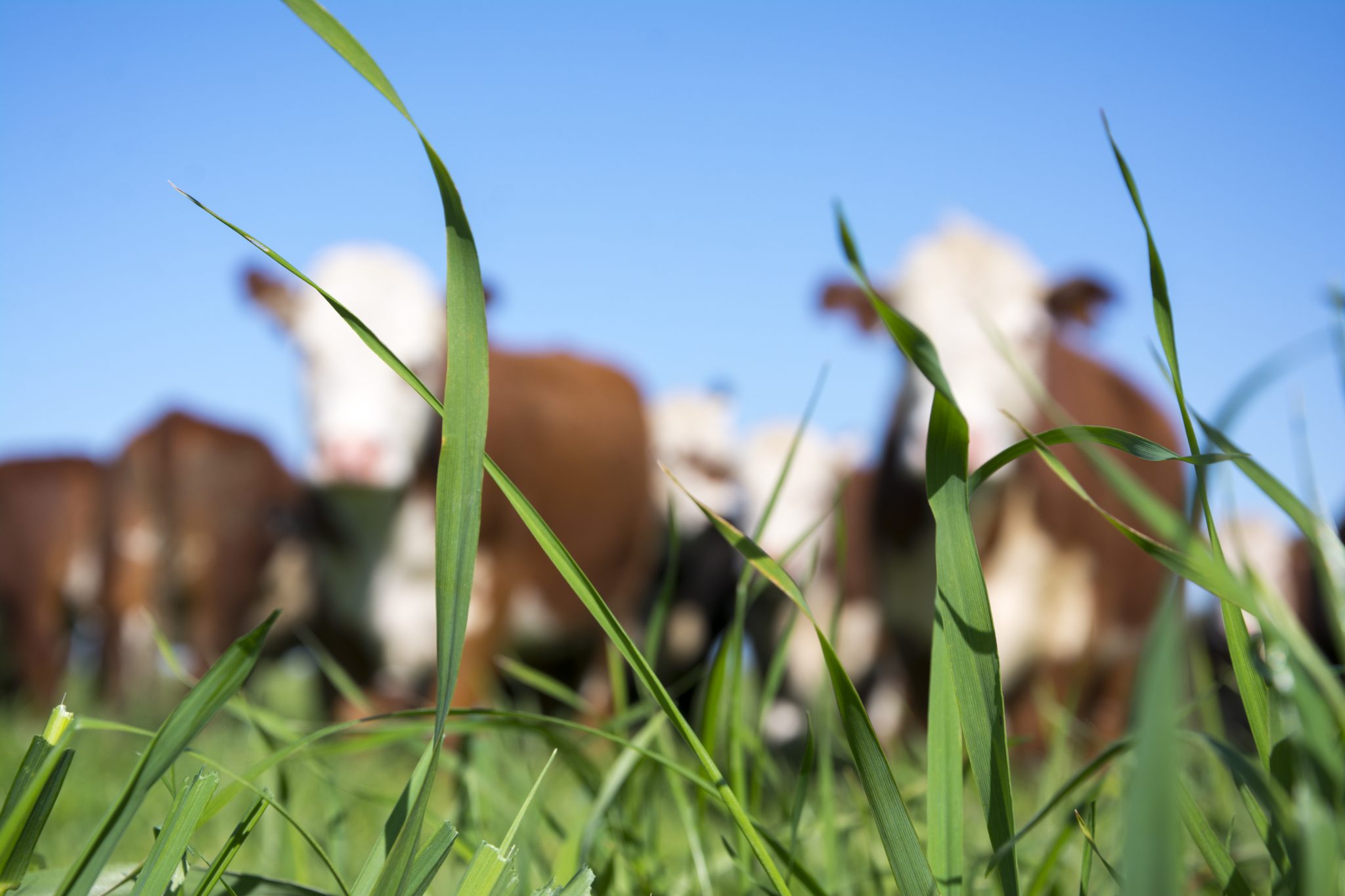Beef

Analysis of forages is an important tool to develop strategic supplemental feeding strategies for beef cattle. Understanding the nutritional level of available forage can help manage feed input costs more closely and meet the nutritional demands of the herd more accurately.
The Auburn University Soil, Forage, and Water Testing Laboratory provides producers with a detailed forage analysis that includes important nutritional components such as dry matter (moisture), total digestible nutrients, crude protein, fiber, nitrate-nitrogen, relative forage quality, and mineral concentration. This overview of the testing procedure provides definitions of these terms to help you start interpreting a forage analysis report. A more detailed interpretation and assistance with balancing rations can be obtained by contacting your Animal Science and Forage regional Extension agent. Find your agent at www.aces.edu/directory.
A forage analysis will have two columns of numbers on the report. The first column is on a dry matter basis, and the second is on an as-fed or as-received basis. When interpreting a forage analysis report for developing a supplemental feeding strategy, all interpretation is based on the dry matter basis column. Moisture levels may vary across samples. Comparing forages on a 100% dry matter basis allows for a more equal comparison among forage types.
Definitions
Dry Matter (DM), %. Forage samples are oven dried to determine the amount of water and dry matter in a sample. Understanding the dry matter % influences how stable stored forages such as hay, baleage, and silage may be during storage. A goal of 85% dry matter is preferred for hay. Baleage may contain between 40 and 60% dry matter, and silage between 30 and 40% dry matter to ferment properly.

Figure 1. Relative forage quality requirements based on animal class and stage of production.
Crude Protein (CP), %. Crude protein is the total nitrogen in a forage sample multiplied by a 6.25 correction factor. Protein is important for growth, milk production, and muscle development. A lactating cow needs a diet containing 11% CP on a daily basis during the first 60 days after calving. During mid-to-late lactation, CP needs decrease to 9%. A dry, pregnant cow has the lowest CP needs (7%) until the last 60 days before calving when nutrient needs begin to increase again.
Fiber Components
Neutral Detergent Fiber (NDF)
The NDF value is the total cell wall, which consists of hemicellulose, cellulose, and lignin. As forage NDF increases, forage intake decreases. The percentage of dry matter intake of the animal as a percentage of their body weight per day can be estimated as 120/NDF. For example, if the forage report has a dry matter NDF value of 60%, then dry matter intake (as a % of body weight) = 120/60 = 2.0%. The calculated, estimated dry matter intake of this forage is 2.0% of the animal’s body weight.
Acid Detergent Fiber (ADF)
Acid detergent fiber is an estimation of the component of the forage that is indigestible to the animal. This value refers to the cell wall portions of the forage that are made up of cellulose and lignin. The greater the ADF, the less digestible forages become to the animal. Both NDF and ADF increase as the forage becomes more mature because of increasing cell wall content. Most forages have an ADF value of 40% or greater. The ADF value is used to determine the total digestible nutrients of the forage.
Total Digestible Nutrients (TDN)
Energy value of a forage is expressed as total digestible nutrients. Typically, the greater the value, the more energy-dense the forage is considered. Low-quality hay is generally 45 to 52% TDN. Mid-quality hay is generally 52% to 58% TDN, and high-quality hay is greater than or equal to 58% TDN. A dry cow requires a minimum of 48% TDN, and a lactating cow needs a diet that is at least 60% TDN per day.

Key Minerals
Calcium (Ca) and Phosphorous (P), %. Calcium and phosphorous are important minerals in beef cattle diets. A dry cow requires 0.25% Ca and 0.16% P in their diet on a daily basis. Cows in peak lactation need 0.31% Ca and 0.21% P. A Ca-to-P ratio of 2:1 to 4:1 is desirable. When P levels are higher than Ca levels, a high calcium mineral supplement should be used. Most of the time, however, a standard, complete mineral is sufficient. More information on selecting a mineral supplement is available in Extension publication ANR- 2209, “Considerations for Mineral Supplementations for Cow-Calf Operations.”
Additional Measures
Relative Forage Quality (RFQ)
This is a single number that can be used to compare the overall quality of one or more forage samples. The RFQ value combines an estimate of predicted intake and digestibility, which makes it a good measure of forage quality and can help provide insight on potential animal performance. In general, RFQ values range from 50 to 250, with the upper end representing the highest-quality forage. Figure 1 illustrates RFQ values and the expected ability of the forage to meet animal nutrient requirements. The greater the nutrient demands, the greater quality forage needed to support animal performance.
Nitrate-Nitrogen, ppm
Plants under stress can accumulate excessive amounts of nitrates, which at high levels can be toxic to livestock. Forage crops such as Sorghum sp., summer annuals, and bermudagrass may accumulate nitrates under conditions of high fertility, drought stress, etc. Table 1 shows the threshold for acceptable feeding values.
pH
This is a measure of the degree of acidity in ensiled forage crops. Good corn or sorghum silage generally has a pH of 3.5 to 4.5, and baleage from 3.5 to 5.5.
Table 1. Level of Nitrate-Nitrogen in Forages and Expected Level of Feeding Risk
| Nitrate Nitrogen (NO3-N), ppm, DM Basis | Level of Risk |
|---|---|
| 0 to 1,500 | Generally safe to feed. In upper range, use caution when feeding pregnant or young animals, and prevent over-consumption frequently observed in feeding large round bales. |
| 1,500 to 5,000 | Limit to half of the total dry matter intake. Feed a balanced ration with adequate energy. Do not feed with liquid feed or other nonprotein nitrogen supplements. |
| 5,000 + | TOXIC. Do not use in free-choice feeding situations. Feed containing such levels of nitrates may be ground and mixed if the nitrate-containing feed contributes to no more than 15% of total ration by weight. |
Applying This Information on the Farm
- Review your forage analysis results to determine overall quality on a dry matter basis.
- Compare the expected dry matter intake, total digestible nutrients, protein, calcium, and phosphorous values to the nutrient requirements of your herd. Daily nutrient requirements of beef cattle during different stages of production can be found in Extension publication ANR-0060, “Nutrient Requirements of Beef Cattle.”
If forage report values are less than the daily nutrient needs, additional supplemental feeds may be needed in the diet. Contact your local Animal Science and Forage Extension agent for information on developing balanced rations.
To obtain analyses, submit Alabama forage and feed samples to the following:
Auburn Soil, Forage, and Water Testing Laboratory
961 S. Donahue Drive
Auburn University, AL 36849
Phone: (334) 844-3958
Find submission forms at www.aces. edu/anr/soillab/forms/index.php
Download a PDF of Interpreting a Forage Analysis for Beef Cattle, ANR-2466.

